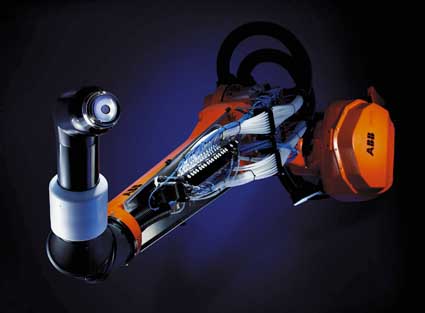 In order to further promote the development of the robot industry, under the guidance of the National Development and Reform Commission, the Ministry of Industry and Information Technology, and the Ministry of Science and Technology, under the active participation of major domestic robot companies, universities, colleges and research institutes, the Chinese Machinery Industry The “China Robot Industry Alliance†led by the Federation was established in Beijing on April 21, 2013.
In order to further promote the development of the robot industry, under the guidance of the National Development and Reform Commission, the Ministry of Industry and Information Technology, and the Ministry of Science and Technology, under the active participation of major domestic robot companies, universities, colleges and research institutes, the Chinese Machinery Industry The “China Robot Industry Alliance†led by the Federation was established in Beijing on April 21, 2013. The China Robotics Industry Alliance is a nationwide collaborative production, learning, research, and promotion platform for the robotics industry in China. It promotes the development of the robot industry with the goal of implementing relevant national industrial policies and serving the government, service companies, and service markets.
According to the prediction of the International Robot Federation, China will become the world’s largest consumer of industrial robots by 2014. It is estimated that by 2015, the demand for the robot market in China will reach 35,000 units, accounting for 16.9% of the global total and becoming the largest robot market. Experts said that in the next three years, the compound growth rate of the Chinese industrial robot market could reach 30%, and the explosive growth could be expected.
Looking at the world, the third wave of industrial revolution with "digital intelligent manufacturing" as its core has arrived. The protagonist of this revolution is industrial robots. Under the background of the weakening of China’s demographic dividend, China’s industrialization must create new competitiveness, and the application of robots in production lines will increase. Some experts predict that Chinese industrial robots will usher in spurt development within a few years, rather than simply increase linearly.
In the transition process of emerging industries and traditional industries, robots all play a "catalyst" role. In the construction machinery industry, robots often perform spot welding, arc welding, painting, and assembly on the production line, which can not only ensure the stability of product quality, improve labor productivity, but also improve workers' working conditions and labor intensity. In recent years, China's construction machinery industry has ushered in rapid development and it is urgently needed to upgrade and transform. In order to compete for greater market share in the fierce competition and get rid of the homogenization of products, we must strengthen the automation level of the production line and vigorously introduce robots. Or missing.
Although major companies are faced with the pains of transformation and upgrading, many companies with strength and long-term vision have found new ways in this pain. Shantui, as a leading construction machinery manufacturer in China and a leading enterprise in the bulldozer industry, should have reached the forefront of domestic counterparts in the application of automated welding equipment. It began to use welding robots and automated welding machines in the mid-1990s. These measures have not only effectively improved the company's production efficiency, but also changed the traditional concept of employees.
The benefits of the introduction of robots can also be seen in the rapid development of Sany Heavy Machinery. In 2007, two robots appeared on the Sany Heavy Machinery production line. Since then, corporate sales have grown by leaps and bounds, and the robot team has grown. In the near-port industrial park of Sany Heavy Machinery, which recently put into production, we can see that more than 200 robots perform their duties and are busy cutting, welding, painting, or gluing. Good hand.
At the end of 2012, the welding robot production system for the welding robots in mixer trucks was officially launched at the Zoomlion Hanjiang Industrial Park, which was the first time in the domestic concrete machinery industry.
Although there has been no shortage of “crab-eating people,†the industry is still some days away from large-scale robot applications. While seeing the advanced level of automation in the automotive production line, we see that the production line of construction machinery is still dominated by manpower, and the level of self-determination is weak.
This has a lot to do with the characteristics of construction machinery products. Components themselves are important, the structure is complex, the welding quality is demanding, the workload is huge, and the variety and models are many, which restricts the development of the automation level of the construction machinery production line. Secondly, due to the complexity and precision of robot construction, high demands are placed on maintenance personnel. Sometimes, they also require the assistance of manufacturers. They also impose higher requirements on the quality of workers who operate robots. Teaching programming and troubleshooting are all required. A certain amount of expertise. In addition, the original welding robots were originally imported, the accessories were not easy to prepare, and the use cost was high. Automation requires benefits, not simply speed. In the initial application of robots, many companies also took some detours and the flexibility of robots has not been fully utilized. According to the survey, some companies have introduced arc welding robots, because of various reasons, there are still some states that are under load or unable to operate normally, which directly affects the confidence of more companies in using robots.
The development of construction machinery lines towards automation, flexibility, and intelligence is a big direction, and the application of robots will certainly inject new vitality into the development of the industry. Since there are national key support policies for the “Twelfth Five-Year Planâ€, it is believed that the “backlash†of robots in the construction machinery production line is just around the corner.
PP103 series cnc Punching Machine special CNC machine for punching and marking of steel plates in the field of steel tower industry. It is also used to punch and mark of steel plates of other industries.
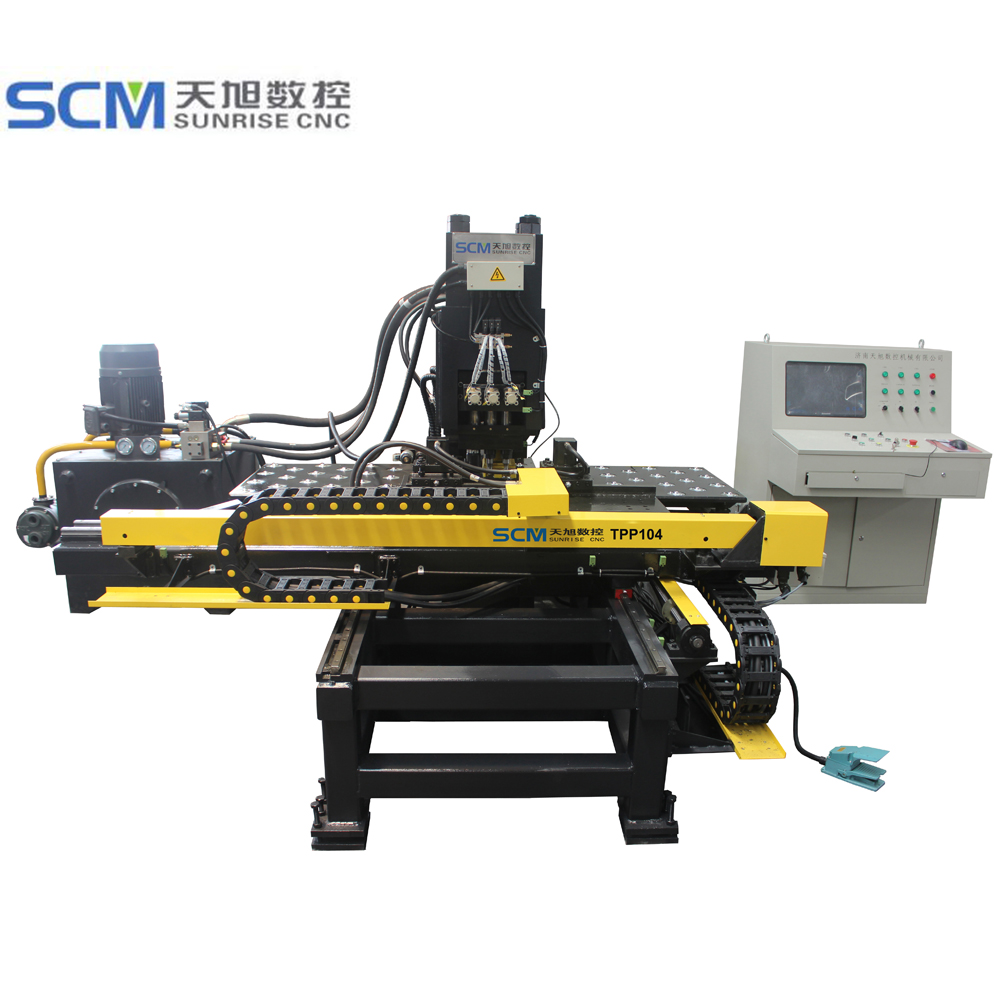
The main machine is a special hydraulic press which is equipped with pressure apparatus and drill drift holding device. There are three drill drifts on the holding device. They are used to install punch and marking apparatus.The body of the machine uses Type C double-plate jointing structure with the advantage of rigid and high power of anti-eccentric load. The main cylinder is fixed on the body by four high strength bolts which is easy to install and convenient for maintenance.
Product Feature:
1. The machine-frame is made by C-type plate welding, with good rigidity and big handling space. The machine sets three die-stations (two punching, one marking), automatic switching die-stations. Clamping system can be adapted to different workpiece, with reference block, and workpiece supported by rolling-ball working table. X & Y axis action controlled by servo motor and ball-screw driving and PLC, control the position of punching, so as to make the whole machining process automatically. Operator input the workpiece program, it can be used repeatedly
2. Adopt CNC technology, servo motor infeeding, with high efficiency, stable workpiece precision.
3. Important functional components adopt modular assembly, easy to repair it.
4. Achieve punching and marking on the one plate.
5. Easy programming, can read CAD drawing and also can use the program generated by lofting software. It can ready TEKLA lofting software files, such as NC1 format.
6. With self-diagnosis failures function.
7. X, Y axis are driven by servo motor + ball screw + linear guide, the precision is better.
The Work Table

CNC feeding worktable can be divided into fixed part and movable part. The fixed part is set on the ground which is linked with main unit. To the fixed part, alongside the front-back direction of main unit is called Axis Y, and then the fixed part is called Axis Y rack. The movable part is installed on the Axis Y rack through the guide bush which is rolling in straight line, under the driven by the servo motor and ball screw shaft, the movable part is running though the Axis Y to realize precise positioning. To the movable part, alongside the left-right direction of main engine is called Axis X, and then the movable part is called Axis X rack. Axis X rack is closed to the head of the main engine, on both sides which is installed a supporting plate with universal transmission ball to support the work piece. At the back of the Axis X rack, two rolling guide bushes are installed with a sliding plate on the direction of Axis X. Under the driven by the servo motor and ball screw shaft, the sliding plate can running though the Axis X to realize precise positioning.
The Hydraulic Clams
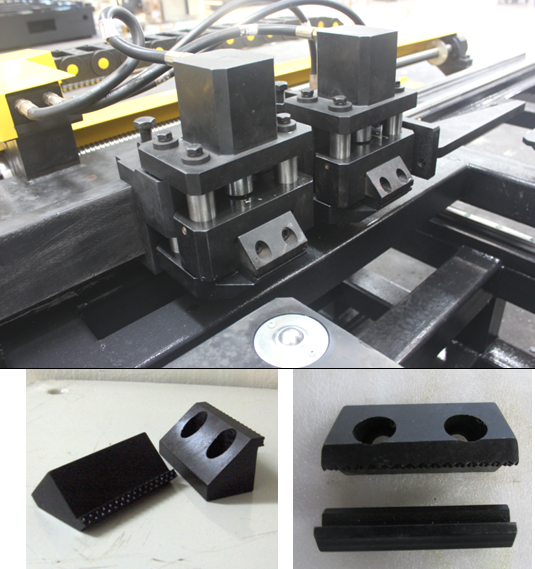
There are two hydraulic clamps on the sliding plate, their location can be moved alongside the Axis X so as to adjust different work piece. While in adjustment, loose the screw and press plate, move the clamp by hand to the adequate place, fasten the screw and press plate again. In the vertical direction, the clamp is in the condition of floating. To the joint plate with slight unevenness, they may be arched during punching, and then the clamp will be moved accordingly to avoid the breakage of clamp. A original location device is installed at the left side of the sliding plate, when the hydraulic cylinder push the locating plate at an angle of 90°, the locating surface is just at the same direction to the Axis Y, and form a rectangle with two clamp surfaces (direction of Axis X) to calibrate the original place of joint plate.
The upper and lower jaws of clamp are spliced which are convenient to replace after abrasion.
The Punching Unit
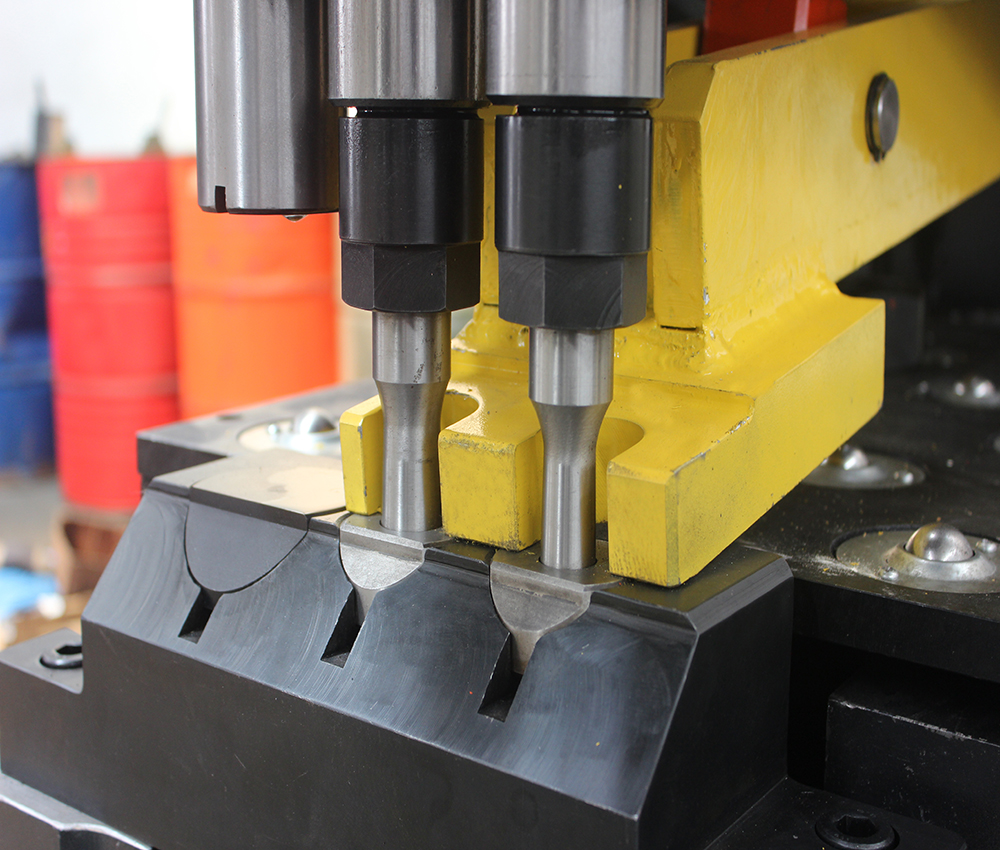
There are one service position of marking and two positions of punching on the machine. While in marking, put the required characters into the character box and fill the vacancy with blank characters, then screw the bolts to tight, insert the character box to the fixed groove at the top of the piston rod. The punching mould shall be selected in accordance with the aperture and plate thickness. The punch is fixed on the rod to tighten the screw, and put the hollowing block into the base of cavity die.
The Manual Lubrication System
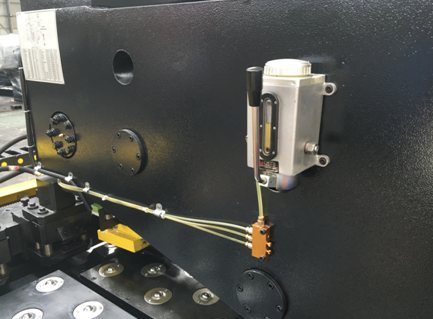
Now we equipped the machine with manual lubrication system, previous client need to lubricate the punching and marking dies one by one, now they just need push the handle, it can lubricate the punching and marking dies simultaneously. The operator don`t need reach out to the inside of machine, It`s more convenient and more security.
(Remark: It`s just need lubricate one or two times of one week, depend on the working environment, if you saw the punching or marking rods dry, then lubricate them.)
When package the machines , our workers will fasten every parts by steel wire rope, so as to when the machine on road, it will not move, ensure security of cargo.
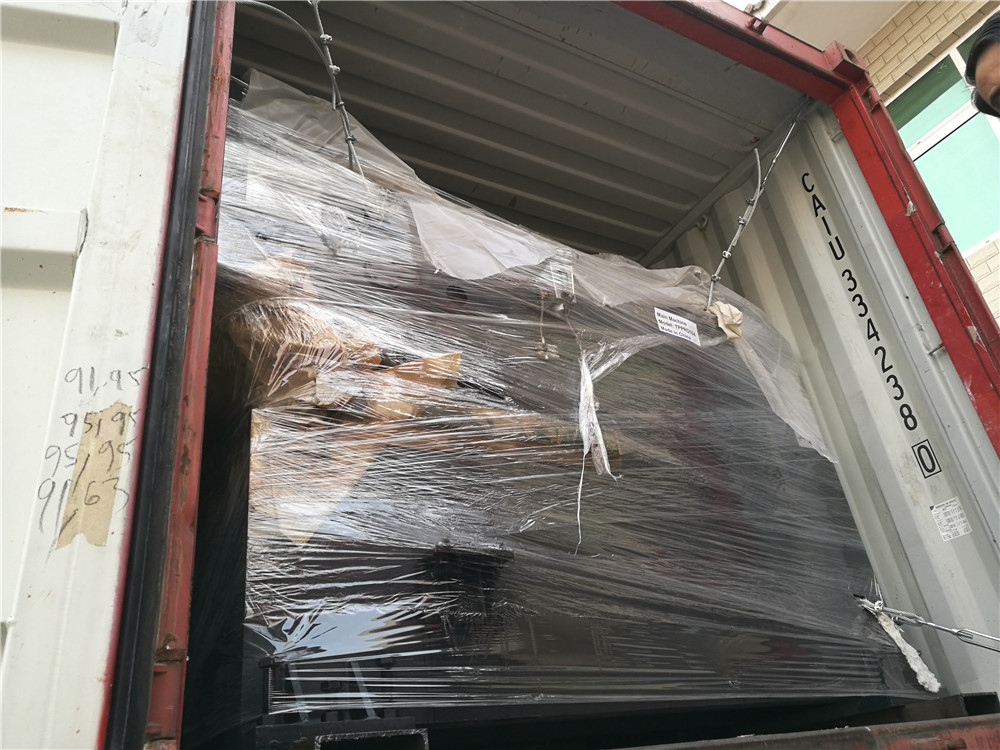
QUALITY MAKE BRAND, HONESTY WIN MARKET!
INNOVATION PROMOTE DEVELOPMENT, HARMONY CONVERGE TALENTS.
THANKS FOR ALL CUSTOMERS BELIEVE AND CHOOSE SUNRISE CNC.
Flange Punching Machine,Flange Hole Punching Machine,Flange Corner Punching Machine,Punching Flanging Press Machine
Shandong Sunrise CNC Machine Co., Ltd , https://www.scmcnc.com
![<?echo $_SERVER['SERVER_NAME'];?>](/template/twentyseventeen/skin/images/header.jpg)